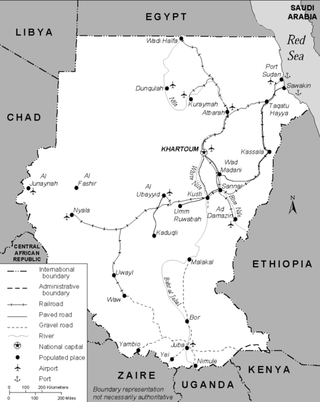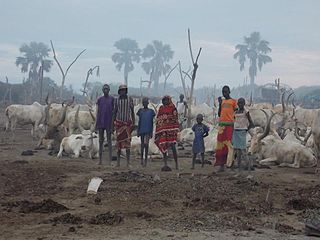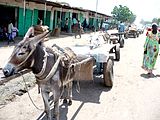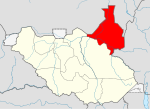
Transport in Sudan during the early 1990s included an extensive railroad system that served the more important populated areas except in the far south, a meager road network, a natural inland waterway—the Nile River and its tributaries—and a national airline that provided both international and domestic service. Complementing this infrastructure was Port Sudan, a major deep-water port on the Red Sea, and a small but modern national merchant marine. Additionally, a pipeline transporting petroleum products extended from the port to Khartoum.

Dongola, also known as Urdu or New Dongola, is the capital of the state of Northern Sudan, on the banks of the Nile. It should not be confused with Old Dongola, a now deserted medieval city located 80 km upstream on the opposite bank.
Sarh, formerly French colonial Fort Archambault, is the capital of the Moyen-Chari Region and of the Department of Barh Köh in Chad.

Juba is the capital and largest city of South Sudan. The city is situated on the White Nile and also serves as the capital of the Central Equatoria State. It is the most recently declared national capital and had a population of 525,953 in 2017. It has an area of 52 km2 (20 sq mi), with the metropolitan area covering 336 km2 (130 sq mi).

Kodok or Kothok, formerly known as Fashoda, is a town in the north-eastern South Sudanese state of Upper Nile. Kodok is the capital of Shilluk country, formally known as the Shilluk Kingdom. Shilluk had been an independent kingdom for more than sixteen centuries. Fashoda is best known as the place where the British and French nearly went to war in 1898 in the Fashoda Incident.

Rumbek is the capital of Lakes State in the Bahr el Ghazal Region of South Sudan.

The Shilluk is a major Luo Nilotic ethnic group that resides in the northeastern Upper Nile state of South Sudan on both banks of the Nile River in Malakal. Before the Second Sudanese Civil War, the Shilluk also lived in settlements on the northern bank of the Sobat River, close to where the Sobat joins the Nile.

Wau is a city in northwestern South Sudan, on the western bank of the Jur River, that serves as capital for Western Bahr el Ghazal. It lies approximately 650 kilometres (400 mi) northwest of the capital Juba. A culturally, ethnically and linguistically diverse urban center and trading hub, Wau is also the former headquarters of Western Bahr el Ghazal.
Ad-Damazin is the capital city of Blue Nile, Sudan. It is the location of the Roseires Dam and power generation plant.

Cruzeiro do Sul is a municipality located on the Juruá river in the west of the Brazilian state of Acre. It is the second-largest city in Acre.
Doleib Hill was a mission station established by the American Inland Mission in southern Sudan, located approximately 10 miles (16 km) south of the city of Malakal, on the northern bank of the Sobat River, then in the former Upper Nile province of Sudan, the present day Upper Nile state of South Sudan.
Malakal Airport is an airport serving Malakal, a city in Malakal County in the Upper Nile State of South Sudan. The airport is located just north of the city's central business district, adjacent to the main campus of Upper Nile University. Malakal is near the international border with the Republic of Sudan and the border with Ethiopia.

The Shilluk Kingdom, dominated by the Shilluk people, was located along the left bank of the White Nile in what is now South Sudan and southern Sudan. Its capital and royal residence were in the town of Fashoda. According to Shilluk folk history and neighboring accounts, the kingdom was founded by Nyikang, who probably lived in the second half of the 15th century. A Nilotic people, the Shilluk managed to establish a centralized kingdom that reached its apogee in the late 18th and early 19th centuries, during the decline of the northern Funj Sultanate. In the 19th century, the Shilluk were affected by military assaults from the Ottoman Empire, resulting in the destruction of the kingdom in the early 1860s. The Shilluk king is currently not an independent political leader, but a traditional chieftain within the governments of South Sudan and Sudan. The current Shilluk king is Reth Kwongo Dak Padiet who ascended to the throne in 1993.
Ramciel is a location in South Sudan that will serve as the site of the future national capital. John Garang, the third president of Southern Sudan, allegedly wanted to place the national capital in Ramciel during his administration, but he died before South Sudan achieved independence and its largest city of Juba became the capital instead.

Gabriel Gatwech Chan, more commonly known by the nickname Tang-Ginye or Tanginye meaning "long pipe", was a Nuer and a commander in various primarily Nuer rebel militias in South Sudan. General Tanginye led a southern border militia allied to the Khartoum government during Sudan's civil war. Members of the Sudanese armed forces loyal to Tanginye in Malakal clashed with the Sudan People's Liberation Army (SPLA) in 2006, killing about 150 people, and in 2009 in breach of the peace deal. In April 2011, clashes between his militia and the SPLA in the state of Jonglei killed at least 57 according to government officials. Shortly thereafter, Tanginye surrendered to SPLA forces and was placed under house arrest in Juba awaiting charges against him. During the South Sudanese Civil War, he allied with the SPLA-IO and later Lam Akol's militia, a Juba linked rebel group called the National Democratic Movement (NDM) and became its chief of staff. In January 2017 he visited a NDM-allied group, the Tiger Faction New Forces, in the Hamra area in the northern Upper Nile. In course of this visit, the Tigers were attacked by SPLM-IO-affiliated fighters belonging to the militia of John Uliny, and Tanginye was killed alongside most of the Tigers.
Upper Nile University (UNU) is a university in South Sudan.

The South Sudanese Civil War was a multi-sided civil war in South Sudan between forces of the government and opposition forces. In December 2013, President Salva Kiir accused his former deputy Riek Machar and 10 others of attempting a coup d'état. Machar denied trying to start a coup and fled to lead the Sudan People's Liberation Movement-in-Opposition (SPLM-IO). Fighting broke out between the Sudan People's Liberation Movement (SPLM) and SPLM-IO, igniting the civil war. Ugandan troops were deployed to fight alongside the South Sudanese government. The United Nations has peacekeepers in the country as part of the United Nations Mission in South Sudan (UNMISS).
John Uliny, also known as Johnson Olony, Johnson Olonyi, and John Olony, is a South Sudanese militia leader. He is a member of the Shilluk ethnic group. He has at various points in time been allied with the South Sudan Democratic Movement, the Sudan People's Liberation Movement-in-Opposition and has led his own Agwelek Forces. He fought the South-Sudanese government in Upper Nile State between 2016 and 2018.

Eastern Nile was a state in South Sudan that existed between 2 October 2015 and 14 January 2017 when it was divided into Central Upper Nile State and Northern Upper Nile State. It was located in the Greater Upper Nile region and it was part of the former states of Upper Nile and Jonglei. The state bordered the states of Eastern Bieh, Latjoor, Western Bieh, Fashoda State, and the country of Ethiopia to the east.
The Tiger Faction New Forces was a Shilluk militia that took part in the South Sudanese Civil War with the aim of reversing the division of South Sudan into 28 states in order to restore the territory of the Shilluk Kingdom per its 1956 borders. Led by Yoanis Okiech, the TFNF originally split from the Sudan People's Liberation Army (SPLA) in late October 2015 and subsequently started an insurgency against the SPLM government. In course of 2016, however, it also came into conflict with SPLM-IO rebels, leading to inter-rebel fighting which resulted in Okiech's death and the group's destruction in January 2017.






















